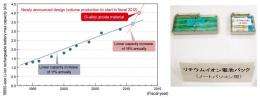March 1, 2010 weblog
Panasonic's Si-alloy anode technology to offer 30% increase in battery capacity
Lisa Zyga
contributing writer

(Â鶹ÒùÔºOrg.com) -- One promising modification to next-generation rechargeable Li-ion batteries involves using Si-alloy anodes instead of graphite, which is currently the most common anode material. Many battery manufacturers are developing Si-alloy anodes, with Hitachi Maxell having previously announced plans to begin volume production by the end of fiscal 2009. Now, with its announcement of beginning volume production in 2012, Panasonic is the first company to reveal specifications of its Si-alloy anode product.
Namely, the batteries, which measure 18mm in diameter and 65 mm in length, will offer a 4.0Ah capacity - that's almost 30% higher than the largest capacity (3.1Ah) of today's batteries of the same size. Panasonic plans to use the batteries primarily in notebook PCs, in which the Si-alloy anode makes it possible to cut the volume of a standard notebook PC battery pack by about half. Panasonic also hinted at using the batteries in vehicles in the future, although the battery's weight will have to be reduced.
Si-alloy's attraction lies in its high theoretical capacity, which is at least 10 times greater than the capacity of graphite. However, one of the greatest challenges in developing Si-alloy-anode batteries is increasing their short charge/discharge cycle lifetime. During charge and discharge, the batteries have a large volumetric change of about 400%, which decreases their lifetime.
With improved fabrication techniques and other modifications, Panasonic claims to have reduced the deterioration caused by the volumetric change. The company says that its Si-alloy-anode batteries can still maintain at least 80% capacity after 500 charge/discharge cycles. As the tech news site Nikkei notes, Panasonic's commercial launch should further accelerate the Si-alloy development competition.
Written for you by our author —this article is the result of careful human work. We rely on readers like you to keep independent science journalism alive. If this reporting matters to you, please consider a (especially monthly). You'll get an ad-free account as a thank-you.
More information: via:
© 2010 Â鶹ÒùÔºOrg.com



















